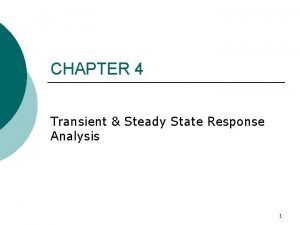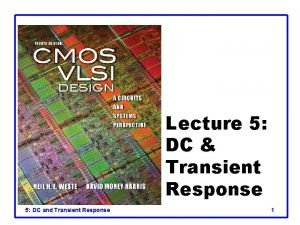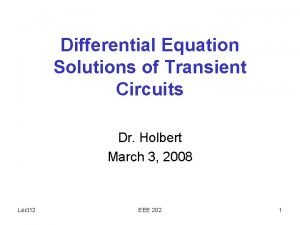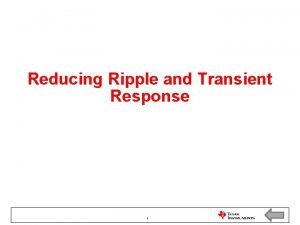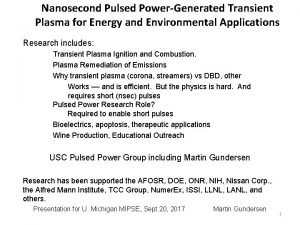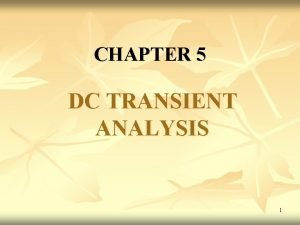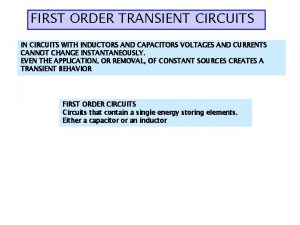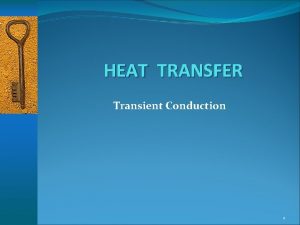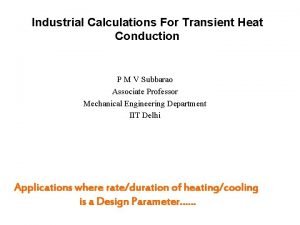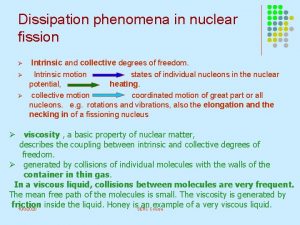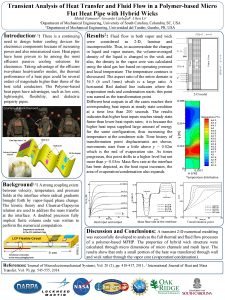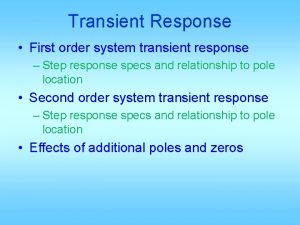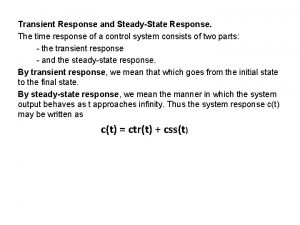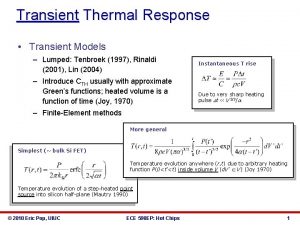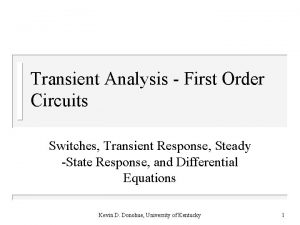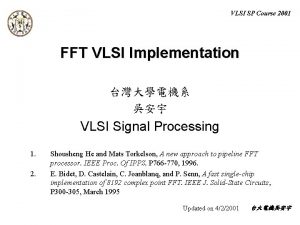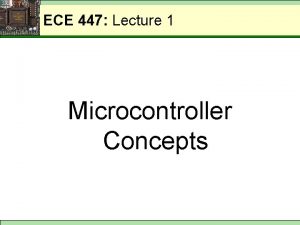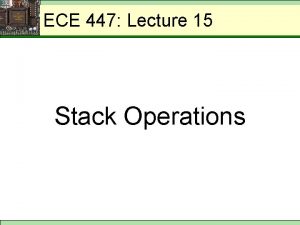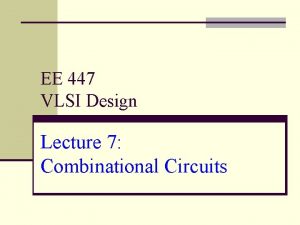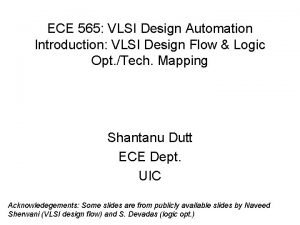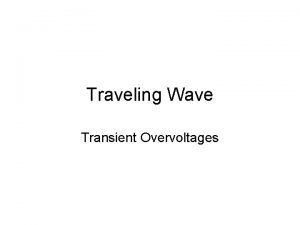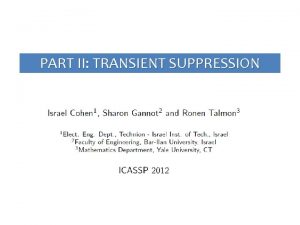VLSI Design DC Transient Response EE 447 VLSI















































- Slides: 47

VLSI Design DC & Transient Response EE 447 VLSI Design 4: DC and Transient Response 1

Outline n n DC Response Logic Levels and Noise Margins Transient Response Delay Estimation EE 447 VLSI Design 4: DC and Transient Response 2

DC Response n n DC Response: Vout vs. Vin for a gate Ex: Inverter n n n When Vin = 0 -> Vout = VDD When Vin = VDD -> Vout = 0 In between, Vout depends on transistor size and current By KCL, must settle such that Idsn = |Idsp| We could solve equations But graphical solution gives more insight EE 447 VLSI Design 4: DC and Transient Response 3

Transistor Operation n n Current depends on region of transistor behavior For what Vin and Vout are n. MOS and p. MOS in n Cutoff? Linear? Saturation? EE 447 VLSI Design 4: DC and Transient Response 4

I-V Characteristics n Make p. MOS is wider than n. MOS such that bn = bp EE 447 VLSI Design 4: DC and Transient Response 5

Current vs. Vout, Vin EE 447 VLSI Design 4: DC and Transient Response 6

Load Line Analysis n For a given Vin: n n Plot Idsn, Idsp vs. Vout must be where |currents| are equal in EE 447 VLSI Design 4: DC and Transient Response 7

Load Line Analysis n Vin = 0 EE 447 VLSI Design 4: DC and Transient Response 8

Load Line Analysis n Vin = 0. 2 VDD EE 447 VLSI Design 4: DC and Transient Response 9

Load Line Analysis n Vin = 0. 4 VDD EE 447 VLSI Design 4: DC and Transient Response 10

Load Line Analysis n Vin = 0. 6 VDD EE 447 VLSI Design 4: DC and Transient Response 11

Load Line Analysis n Vin = 0. 8 VDD EE 447 VLSI Design 4: DC and Transient Response 12

Load Line Analysis n Vin = VDD EE 447 VLSI Design 4: DC and Transient Response 13

Load Line Summary EE 447 VLSI Design 4: DC and Transient Response 14

DC Transfer Curve n Transcribe points onto Vin vs. Vout plot EE 447 VLSI Design 4: DC and Transient Response 15

Operating Regions n Revisit transistor operating regions Region n. MOS p. MOS A Cutoff Linear B Saturation Linear C Saturation D Linear Saturation E Linear Cutoff EE 447 VLSI Design 4: DC and Transient Response 16

Beta Ratio n n n If bp / bn 1, switching point will move from VDD/2 Called skewed gate Other gates: collapse into equivalent inverter EE 447 VLSI Design 4: DC and Transient Response 17

Noise Margins n How much noise can a gate input see before it does not recognize the input? EE 447 VLSI Design 4: DC and Transient Response 18

Logic Levels n To maximize noise margins, select logic levels at n unity gain point of DC transfer characteristic EE 447 VLSI Design 4: DC and Transient Response 19

Transient Response n n DC analysis tells us Vout if Vin is constant Transient analysis tells us Vout(t) if Vin(t) changes n n Requires solving differential equations Input is usually considered to be a step or ramp n From 0 to VDD or vice versa EE 447 VLSI Design 4: DC and Transient Response 20

Inverter Step Response n Ex: find step response of inverter driving load cap EE 447 VLSI Design 4: DC and Transient Response 21

Inverter Step Response n Ex: find step response of inverter driving load cap EE 447 VLSI Design 4: DC and Transient Response 22

Inverter Step Response n Ex: find step response of inverter driving load cap EE 447 VLSI Design 4: DC and Transient Response 23

Inverter Step Response n Ex: find step response of inverter driving load cap EE 447 VLSI Design 4: DC and Transient Response 24

Inverter Step Response n Ex: find step response of inverter driving load cap EE 447 VLSI Design 4: DC and Transient Response 25

Inverter Step Response n Ex: find step response of inverter driving load cap EE 447 VLSI Design 4: DC and Transient Response 26

Delay Definitions n tpdr: n tpdf: n tpd: n tr : n tf: fall time EE 447 VLSI Design 4: DC and Transient Response 27

Delay Definitions n n n tpdr: rising propagation delay n From input to rising output crossing V DD/2 tpdf: falling propagation delay n From input to falling output crossing V DD/2 tpd: average propagation delay n tpd = (tpdr + tpdf)/2 tr: rise time n From output crossing 0. 2 VDD to 0. 8 VDD tf: fall time n From output crossing 0. 8 VDD to 0. 2 VDD EE 447 VLSI Design 4: DC and Transient Response 28

Delay Definitions n n n tcdr: rising contamination delay n From input to rising output crossing V DD/2 tcdf: falling contamination delay n From input to falling output crossing V DD/2 tcd: average contamination delay n tpd = (tcdr + tcdf)/2 EE 447 VLSI Design 4: DC and Transient Response 29

Simulated Inverter Delay n n n Solving differential equations by hand is too hard SPICE simulator solves the equations numerically n Uses more accurate I-V models too! But simulations take time to write EE 447 VLSI Design 4: DC and Transient Response 30

Delay Estimation n We would like to be able to easily estimate delay n n n The step response usually looks like a 1 st order RC response with a decaying exponential. Use RC delay models to estimate delay n n Not as accurate as simulation C = total capacitance on output node Use effective resistance R So that tpd = RC Characterize transistors by finding their effective R n Depends on average current as gate switches EE 447 VLSI Design 4: DC and Transient Response 31

RC Delay Models n Use equivalent circuits for MOS transistors n n n Ideal switch + capacitance and ON resistance Unit n. MOS has resistance R, capacitance C Unit p. MOS has resistance 2 R, capacitance C Capacitance proportional to width Resistance inversely proportional to width EE 447 VLSI Design 4: DC and Transient Response 32

Example: 3 -input NAND n A 3 -input NAND with transistor widths chosen to achieve effective rise and fall resistances equal to a unit inverter (R). EE 447 VLSI Design 4: DC and Transient Response 33

3 -input NAND Caps n Annotate the 3 -input NAND gate with gate and diffusion capacitance. EE 447 VLSI Design 4: DC and Transient Response 34

3 -input NAND Caps n Annotate the 3 -input NAND gate with gate and diffusion capacitance. EE 447 VLSI Design 4: DC and Transient Response 35

Elmore Delay n n n ON transistors look like resistors Pullup or pulldown network modeled as RC ladder Elmore delay of RC ladder EE 447 VLSI Design 4: DC and Transient Response 36

Example: 2 -input NAND n Estimate worst-case rising and falling delay of 2 -input NAND driving h identical gates. EE 447 VLSI Design 4: DC and Transient Response 37

Example: 2 -input NAND n Estimate rising and falling propagation delays of a 2 input NAND driving h identical gates. EE 447 VLSI Design 4: DC and Transient Response 38

Example: 2 -input NAND n Estimate rising and falling propagation delays of a 2 input NAND driving h identical gates. EE 447 VLSI Design 4: DC and Transient Response 39

Example: 2 -input NAND n Estimate rising and falling propagation delays of a 2 input NAND driving h identical gates. EE 447 VLSI Design 4: DC and Transient Response 40

Example: 2 -input NAND n Estimate rising and falling propagation delays of a 2 input NAND driving h identical gates. EE 447 VLSI Design 4: DC and Transient Response 41

Example: 2 -input NAND n Estimate rising and falling propagation delays of a 2 input NAND driving h identical gates. EE 447 VLSI Design 4: DC and Transient Response 42

Example: 2 -input NAND n Estimate rising and falling propagation delays of a 2 input NAND driving h identical gates. EE 447 VLSI Design 4: DC and Transient Response 43

Delay Components n Delay has two parts n Parasitic delay n n n 6 or 7 RC Independent of load Effort delay n n 4 h RC Proportional to load capacitance EE 447 VLSI Design 4: DC and Transient Response 44

Contamination Delay n n Best-case (contamination) delay can be substantially less than propagation delay. Ex: If both inputs fall simultaneously EE 447 VLSI Design 4: DC and Transient Response 45

Diffusion Capacitance n n n we assumed contacted diffusion on every s / d. Good layout minimizes diffusion area Ex: NAND 3 layout shares one diffusion contact n n Reduces output capacitance by 2 C Merged uncontacted diffusion might help too EE 447 VLSI Design 4: DC and Transient Response 46

Layout Comparison n Which layout is better? EE 447 VLSI Design 4: DC and Transient Response 47
 Transient response in vlsi
Transient response in vlsi Steady state response example
Steady state response example Rw + vo c inverter transient response vod inverte...
Rw + vo c inverter transient response vod inverte... Unit step response
Unit step response No poder de cristo mestre
No poder de cristo mestre Ideiglenes mérőhely kialakítás
Ideiglenes mérőhely kialakítás Cs 447
Cs 447 Dr sujan ali
Dr sujan ali 649 en yakın onluğa yuvarlama
649 en yakın onluğa yuvarlama 447 bc
447 bc Se 465
Se 465 Gcf of 12 and 24
Gcf of 12 and 24 What is z?
What is z? 18-447
18-447 Cmu 18-447
Cmu 18-447 Natural response and forced response
Natural response and forced response What is natural response
What is natural response A subsequent
A subsequent Stereotypic movement disorder
Stereotypic movement disorder Transient line source system
Transient line source system Secular equilibrium
Secular equilibrium Kutta
Kutta Persistent and transient communication
Persistent and transient communication Jpa weak entity
Jpa weak entity Natural solution
Natural solution Broker's overflowing bucket
Broker's overflowing bucket Example of conditional evidence
Example of conditional evidence Transient evidence examples
Transient evidence examples Alimam
Alimam Transient hypofrontality
Transient hypofrontality Ripple transient
Ripple transient Transient plasma
Transient plasma Surface mount transient voltage suppressor
Surface mount transient voltage suppressor Transient threat definition
Transient threat definition Who
Who Dc transient analysis
Dc transient analysis Examples of transient evidence
Examples of transient evidence Transient signal oscilloscope
Transient signal oscilloscope First order transient circuit
First order transient circuit Transient contact
Transient contact Bobby poole
Bobby poole Transient conduction heat transfer
Transient conduction heat transfer Example of conditional evidence
Example of conditional evidence Examples of conditional evidence
Examples of conditional evidence Transient market segment
Transient market segment Transient heat transfer in industry
Transient heat transfer in industry Transient time
Transient time Transient analysis thermodynamics
Transient analysis thermodynamics

